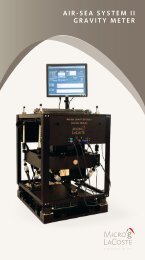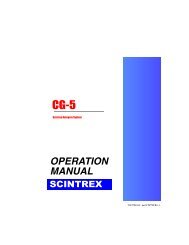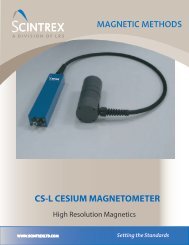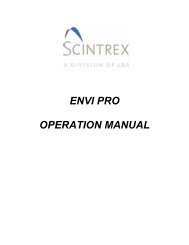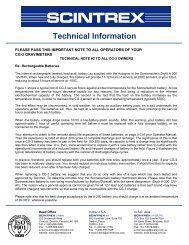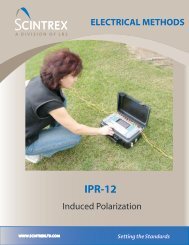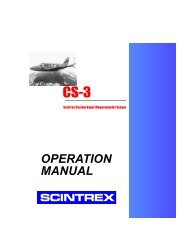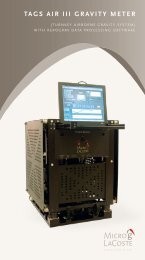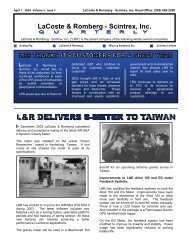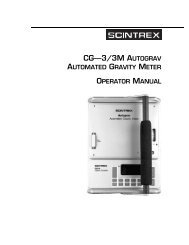- Page 1 and 2:
CG-5Scintrex Autograv SystemOPERATI
- Page 3:
CG-5Scintrex Autograv SysemOperatio
- Page 6:
Entering Alphanumerics, Example 1 .
- Page 9 and 10:
Understanding Life Expectancy . . .
- Page 11 and 12:
Appendix C: Elastic Hysteresis Effe
- Page 13 and 14:
ForewordForewordCongratulations on
- Page 15 and 16:
Data Dump ConnectorsThe system is e
- Page 17 and 18:
• *.SGD (Scintrex proprietary for
- Page 19 and 20:
1 GettingStartedStartupAbout this M
- Page 21 and 22:
About this ManualChapter LayoutThis
- Page 23 and 24:
Understanding Instrument BasicsUnde
- Page 25 and 26:
Understanding Instrument BasicsLoca
- Page 27 and 28:
Understanding Instrument BasicsThe
- Page 29 and 30:
Understanding Instrument BasicsUsin
- Page 31 and 32:
Understanding Instrument BasicsPRES
- Page 33 and 34:
Understanding Instrument BasicsNavi
- Page 35 and 36:
Understanding Instrument BasicsHELP
- Page 37 and 38:
Understanding Instrument Basicsor b
- Page 39 and 40:
Understanding Instrument BasicsPRES
- Page 41 and 42:
Understanding Instrument BasicsEnte
- Page 43 and 44:
Understanding Instrument BasicsIn t
- Page 45 and 46:
Understanding Instrument BasicsPRES
- Page 47 and 48:
Understanding Instrument BasicsAcce
- Page 49 and 50:
Initializing Instrument ParametersU
- Page 51 and 52:
Understanding Instrument BasicsPRES
- Page 53 and 54:
Understanding Instrument BasicsPRES
- Page 55 and 56:
2 Setting UpYourInstrumentSetupBefo
- Page 57 and 58:
Using the Survey ScreenUsing the Su
- Page 59 and 60:
Using the Survey ScreenIf you are u
- Page 61 and 62:
Using the Survey ScreenSpecifying G
- Page 63 and 64:
Using the Survey ScreenPRESSF1Press
- Page 65 and 66:
Using the Autograv ScreenUsing the
- Page 67 and 68:
Using the Autograv ScreenUse the le
- Page 69 and 70:
Using the Autograv ScreenPRESSF3Pre
- Page 71 and 72:
Using the Autograv ScreenDrift:Long
- Page 73 and 74:
Using the Options ScreenDefining Re
- Page 75 and 76:
Using the Options ScreenStart Delay
- Page 77 and 78:
Using the Clock ScreenPRESSF5Press
- Page 79 and 80:
Using the Dump ScreenUsing the Dump
- Page 81 and 82:
Using the Dump ScreenStarting a Dum
- Page 83 and 84:
Using the Memory ScreenPRESSF5Press
- Page 85 and 86:
Using the Service ScreenUsing the S
- Page 87 and 88:
SetupUsing the Service ScreenThe ph
- Page 89 and 90:
Using the Service ScreenEnable Fact
- Page 91 and 92:
3 Operating theCG-5 in theFieldBy n
- Page 93 and 94:
Initializing Field ParametersSettin
- Page 95 and 96:
Initializing Field ParametersType t
- Page 97 and 98:
Initializing Field ParametersEditin
- Page 99 and 100:
Initializing Field ParametersThe se
- Page 101 and 102:
Setting Up the TripodSetting up the
- Page 103 and 104:
Setting Up the TripodNote:Terrain c
- Page 105 and 106:
Setting Up the TripodPress the F1
- Page 107 and 108:
Performing Data AcquisitionFigure 5
- Page 109 and 110:
Performing Data AcquisitionReviewin
- Page 111 and 112:
Performing Data AcquisitionTaking a
- Page 113 and 114:
Performing Data Acquisitioncolumn.
- Page 115 and 116:
Entering NotesEntering NotesDuring
- Page 117 and 118:
Entering NotesThe following screen
- Page 119 and 120:
Entering NotesRecording Notes Using
- Page 121 and 122:
Entering NotesUsing your macros —
- Page 123 and 124:
Recalling DataRecalling DataDuring
- Page 125 and 126:
Recalling DataPRESSF1To display the
- Page 127 and 128:
Recalling DataRecalling Line DataPR
- Page 129 and 130:
Dumping DataNote:Your version of SC
- Page 131 and 132:
Dumping Data• *.sgd. The Scintrex
- Page 133 and 134:
Dumping Datacolumn 2TiltX=((TILTX_S
- Page 135 and 136:
Dumping DataSetting Communication P
- Page 137 and 138:
Dumping DataSetting Communication P
- Page 139 and 140:
Dumping DataYou will then be prompt
- Page 141 and 142:
Dumping DataPRESSF5After you have t
- Page 143 and 144:
Dumping DataDumping Data with the U
- Page 145 and 146:
Dumping DataIn the Dump window of t
- Page 147 and 148:
Reprogramming your CG-5Reprogrammin
- Page 149 and 150:
Reprogramming your CG-5The followin
- Page 151 and 152:
Reprogramming your CG-5Press the ar
- Page 153 and 154:
Clearing MemoryClearing MemoryYou c
- Page 155 and 156:
4 Optimizingyour FieldOperationsIn
- Page 157 and 158:
material and fasten it down with a
- Page 159 and 160:
Selecting Base StationsRepeated gra
- Page 161 and 162:
5Maintaining YourCG-5 andTrouble-sh
- Page 163 and 164:
Using the Smart BatteryUnderstandin
- Page 165 and 166:
Using the Smart BatteryReplacing a
- Page 167 and 168:
Using the Power AdapterCharging Not
- Page 169 and 170:
Using the external battery beltConn
- Page 171 and 172:
Adjusting Instrument ParametersObta
- Page 173 and 174:
Adjusting Instrument ParametersPRES
- Page 175 and 176:
Adjusting Instrument Parameterswher
- Page 177 and 178:
Applying Tilt CorrectionsApplying T
- Page 179 and 180:
Applying Tilt CorrectionsPRESSF3Pre
- Page 181 and 182:
Applying Tilt CorrectionsPRESSENTER
- Page 183 and 184:
Applying Tilt CorrectionsPRESSF1The
- Page 185 and 186:
Applying Tilt CorrectionsPRESSF5In
- Page 187 and 188:
MaintenanceApplying Tilt Correction
- Page 189 and 190:
Adjusting Tilt Sensor Cross- Coupli
- Page 191 and 192:
Adjusting Tilt Sensor Cross- Coupli
- Page 193 and 194:
Re-Calibrating the CG-5greatest pre
- Page 195 and 196:
Trouble-shootingTrouble-shootingDes
- Page 197 and 198:
Trouble-shooting your USB portTroub
- Page 199 and 200: Warranty and RepairShipping Instruc
- Page 201 and 202: 6 ReferenceInformationReferenceThis
- Page 203 and 204: General SpecificationsHardware Spec
- Page 205 and 206: General SpecificationsData StorageS
- Page 207 and 208: General SpecificationsStandard Acce
- Page 209 and 210: Instrument Parts ListInstrument Par
- Page 211 and 212: ARemoteOperation ofthe CG-5For oper
- Page 213 and 214: PRESSF5Press the F5 key. The follo
- Page 215 and 216: RemoteEnter your name and the name
- Page 217 and 218: RemoteDefine a folder name for addi
- Page 219 and 220: This is the main screen used for op
- Page 221 and 222: You are now ready to configure the
- Page 223 and 224: RemoteSelect any corrections that y
- Page 225 and 226: To exit and save your settings, pre
- Page 227 and 228: Measuring DataThe data measuring pr
- Page 229 and 230: To stop measurement, press the Stop
- Page 231 and 232: Dumping DataTo dump data from the C
- Page 233 and 234: To exit from the Memory option, pre
- Page 235 and 236: BTheory ofOperationSystem OverviewT
- Page 237 and 238: TEMPERATURE CONTROLLEDVACUUM CHAMBE
- Page 239 and 240: • the system applies a self-calib
- Page 241 and 242: Example: —Because of the positive
- Page 243 and 244: If, after many years of service, yo
- Page 245 and 246: The formula given in Equation (B.8)
- Page 247 and 248: which occur during the first 5 seco
- Page 249: measurements were recorded with the
- Page 253 and 254: Compensation and Correctionssample
- Page 255 and 256: Compensation and Corrections(16% in
- Page 257 and 258: CElasticHysteresisEffectsAll spring
- Page 259 and 260: In the case of the CG-5, where the
- Page 261 and 262: DScintrex UtilitiesProgramSCTUTILTh
- Page 263 and 264: Installing SCTUTILAfter the Install
- Page 265 and 266: Installing SCTUTILThe following scr
- Page 267 and 268: Installing SCTUTILThe following scr
- Page 269 and 270: Installing your USB driverInstallin
- Page 271 and 272: Installing your USB driver3. Insert
- Page 273 and 274: Installing your USB driver5.Press t
- Page 275 and 276: Installing your USB driverInstallin
- Page 277 and 278: Installing your USB driver3. Select
- Page 279 and 280: Installing your USB driver7. Click
- Page 281 and 282: Installing your USB driver2. Select
- Page 283 and 284: Installing your USB driver5.Click
- Page 285 and 286: Installing your USB driver7. Click
- Page 287 and 288: ECG-5 MenuMapsMenu MapsThis chapter
- Page 289 and 290: Setup Menu MapsSetup Menu MapsSurve
- Page 291 and 292: Setup Menu MapsDump and Service Men
- Page 293 and 294: Measurement Menu MapsTilt Sensitivi
- Page 295 and 296: Other Menu MapsInfo MenuINFOINFO /
- Page 297 and 298: IndexNumerics1/ABC Key 1-162/DEF Ke
- Page 299 and 300: manual method 5-13software method 5
- Page 301 and 302:
UTM Zone 2-7RRECALL/5/MNO Key 1-16R
- Page 303:
Head Office222 Snidercroft RoadConc



